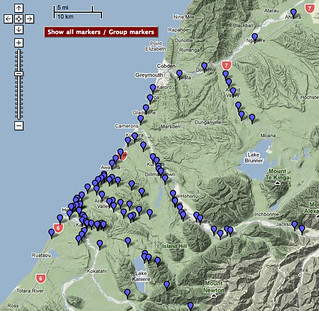NZBRN was part of the recent workshop in Lincoln and Christchurch on GEO-BON, the biodiversity observation network (BON) of the United Nations Group on Earth Observations (GEO). GEO-BON is attempting to establish a global biodiversity observation system to better track biodiversity changes. Biodiversity remains the poor cousin of more thoroughly monitored environmental factors like carbon, nitrogen, climate, and fresh water, despite the world being on the cusp of the biggest extinction event since the loss of the dinosaurs. GEO-BON is trying to change that. Henrique Pereira of GEO-BON visited New Zealand to learn about how we do things here.

Keen NZBRN user Mark Crompton's map of West Coast roads using his Australasian harrier observations.
Henrique started the NZ BioData workshop by introducing us to the problem. It's alarmingly difficult to get a global-scale picture of the biodiversity crisis. Even assessing land cover changes on a global scale is difficult, as the necessary information is scattered. The few high-quality, large-scale, long-term biodiversity datasets, mostly from Europe and North America and strongly biased towards vertebrates, paint a grim picture of widespread ongoing declines in most groups. We need comparable long-term data from a wider variety of groups across the whole world to properly assess the true extent of the biodiversity crisis. Henrique's suggestion is to set up some simple monitoring of birds, butterflies, and plants across a global network of repeatedly visited sites.

Keen NZBRN user Mark Crompton's map of West Coast roads using his Australasian harrier observations.
Henrique started the NZ BioData workshop by introducing us to the problem. It's alarmingly difficult to get a global-scale picture of the biodiversity crisis. Even assessing land cover changes on a global scale is difficult, as the necessary information is scattered. The few high-quality, large-scale, long-term biodiversity datasets, mostly from Europe and North America and strongly biased towards vertebrates, paint a grim picture of widespread ongoing declines in most groups. We need comparable long-term data from a wider variety of groups across the whole world to properly assess the true extent of the biodiversity crisis. Henrique's suggestion is to set up some simple monitoring of birds, butterflies, and plants across a global network of repeatedly visited sites.
More...
It was clear in the workshop that New Zealand is leading the world in many aspects of biodiversity monitoring, especially with the Department of Conservation's Natural Heritage Management System (NHMS) that has begun to repeatedly visit a grid of plots across all of New Zealand's public wildlands. By collaborating with New Zealand's carbon monitoring programme (currently called LUCAS), DOC is monitoring detailed biodiversity information from public wildlands in an 8 km square grid across the whole country. We will be well placed from this to record how native and exotic biodiversity in these plots changes over time as environmental change accelerates (climate, nitrogen cycle, phosphorous cycle, biological invasions, etc.).
NZBRN was well represented at the workshop and I gave a talk about what NZBRN has achieved since we began in 2005. I also gave an overview of where we're heading with our new iNaturalist-based system, which will be launched later this year. You can see a copy of my talk here. (We were pleased to learn that Henrique was well-familar with iNaturalist and they were already in discussions with GEO-BON.)

Here's a copy of our talk on NZBRN at the BioData workshop (3.5 MB PDF).
Henrique concluded that it is a myth that the data is out there to be collated. There's a big role for "citizen science" in collecting data, and most of the long-term biodiversity datasets we have globally are collected wholly or in part by volunteers (just like New Zealand's excellent bird atlas project of the Ornithological Society of New Zealand and the garden bird survey). It's up to us all to collectively open our eyes to the nature around us and watch how our activities are changing the world.
It was clear in the workshop that New Zealand is leading the world in many aspects of biodiversity monitoring, especially with the Department of Conservation's Natural Heritage Management System (NHMS) that has begun to repeatedly visit a grid of plots across all of New Zealand's public wildlands. By collaborating with New Zealand's carbon monitoring programme (currently called LUCAS), DOC is monitoring detailed biodiversity information from public wildlands in an 8 km square grid across the whole country. We will be well placed from this to record how native and exotic biodiversity in these plots changes over time as environmental change accelerates (climate, nitrogen cycle, phosphorous cycle, biological invasions, etc.).
NZBRN was well represented at the workshop and I gave a talk about what NZBRN has achieved since we began in 2005. I also gave an overview of where we're heading with our new iNaturalist-based system, which will be launched later this year. You can see a copy of my talk here. (We were pleased to learn that Henrique was well-familar with iNaturalist and they were already in discussions with GEO-BON.)

Here's a copy of our talk on NZBRN at the BioData workshop (3.5 MB PDF).
Henrique concluded that it is a myth that the data is out there to be collated. There's a big role for "citizen science" in collecting data, and most of the long-term biodiversity datasets we have globally are collected wholly or in part by volunteers (just like New Zealand's excellent bird atlas project of the Ornithological Society of New Zealand and the garden bird survey). It's up to us all to collectively open our eyes to the nature around us and watch how our activities are changing the world.
No comments:
Post a Comment